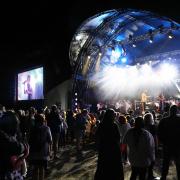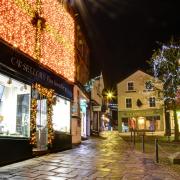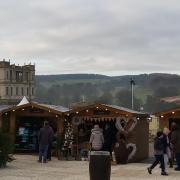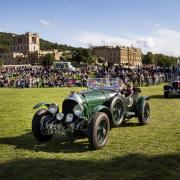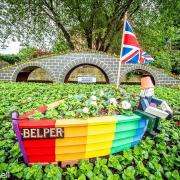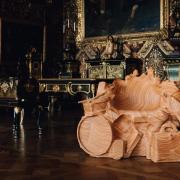750 years ago this May opposing forces met at the peaceful market town of Chesterfield in a climactic battle. Derbyshire Life investigates

Medieval England was brutal and violent and sitting on the throne of England was not a comfortable place to be. Pitched battles across open fields involving thousands of men were not uncommon. However, there was one medieval battle that carried on well into the night, amongst people’s homes, and was witness to some of the most savage violence of the times: ‘The Battle of Chesterfield’.
The battle in 1266 was the result of a decisive action by the royalist army in an attempt to bring to an end the civil war that had been raging for many years known as the Second Barons’ War. To set the scene, 50 years earlier the First Barons’ War (1215-1217) had arisen when a group of the country’s most powerful landowners became increasingly frustrated with the despotic behaviour of King John. The signing of the Magna Carta in 1215 had been an attempt to achieve peace but after signing King John continued to behave as he had before. Under the leadership of Robert Fitzwalter the barons rebelled and with the help of Prince Louis, son and heir of King Philip Augustus of France, captured large areas of southern England.
Although after King John’s death in 1216 many of the barons changed sides to support his young son, King Henry III, Louis would not give up his claim to the English throne and another year of fighting ensued. After a number of defeats, Louis finally gave up his claim to the throne of England and the Treaty of Lambeth on 11th September 1217 marked the end of the war.
However, the underlying problems that had caused it were never solved satisfactorily and the barons’ frustrations surfaced once more during the reign of Henry III, with his ever increasing demands for extra finance at a time of widespread famine. A group of barons led by Simon de Montfort, Earl of Leicester, wanted the King to reaffirm the Magna Carta and give more power to the baronial council. Under duress Henry III signed the ‘Provisions of Oxford’ which gave power to a council of 24 barons, but refused to abide by the agreement. By 1261 both sides had begun to raise an army and in 1264 civil war was declared.

In the fight against the King and his son Prince Edward (later Edward I), Simon found a strong ally in the powerful Robert de Ferrers, 6th Earl of Derby (c.1239-1279) who owned the area in Derbyshire known as Duffield Frith as well as lands in Staffordshire, Nottinghamshire and Lancashire. The Earl had little affection for Edward – until he had come of age in 1260 his estates were under the guardianship of the Prince who had sold the wardship for a fee. The Earl was also in a dispute with the King over the Ferrers family’s claims to Peveril Castle at Castleton. King John had granted the estate to the family but this had been annulled by Henry III who had then awarded Peveril to Edward.
During the fighting Edward attacked Northampton Castle – where he captured the Earl’s brother William, along with Anker de Frescheville, Lord of Crich and Baldwin Wake, Lord of Chesterfield – as well as Tutbury Castle and the Earl’s Castle at Chartley, near Uttoxeter.
The tide turned when Simon de Montfort triumphed at the Battle of Lewes and took the King and Prince Edward prisoner. Ferrers captured Bolsover Castle and Horston Castle, near the village of Horsley in the Amber Valley. By the end of 1264 Robert had also taken Chester and Peveril Castles.
Ferrers’ trouble with Peveril was not over as De Montfort declared his capture of the castle a ‘divers trespass’ and had him imprisoned in the Tower of London. Support for De Montfort was beginning to wane. In 1265 Prince Edward escaped from Kenilworth Castle and met De Montfort at the Battle of Evesham. In one of the bloodiest battles since the Battle of Hastings, no mercy was given to the rebels and most of his army perished with De Montfort.

The King confiscated the estates of surviving rebels, leaving them little to lose from continued resistance. However, Robert de Ferrers, who seemed to lead a charmed life, was pardoned – for a fee. He returned to his castle at Duffield in spring 1266 and made contact with Baldwin Wake, Lord of Chesterfield, and another rebel, John d’Ayville. Baldwin Wake joined him at Duffield with his small army of Lincolnshire men while John d’Ayville was at his estates in North Yorkshire with a much larger force.
Unknown to them a royal army commanded by Henry III’s nephew, Henry of Almain, had marched north to Tutbury Castle. On learning that John d’Ayville was moving south to join forces with the Earl – he had torched several towns including Sheffield – they marched north via Ashbourne and Wirksworth, hoping to intercept them. It is unclear how many men were involved – writers of the time were more interested in the fate of the leaders – but it is believed that there were as many as 1,000 men-at-arms on the royalist side and slightly fewer rebels.
Rather than wait at Duffield Castle, the Earl and Baldwin Wake set off north to meet D’Ayville. Although the River Amber was in flood the rebel forces managed to cross it and entered Chesterfield around midday on 15th May. Chesterfield was then a small market town, mainly situated on the hill around today’s town centre.
John d’Ayville was approaching from the north, the direction of Dronfield, but before he was in sight of the town he was attacked by the royalist force. Suspecting a possible attack, D’Ayville’s men were in armour as he knew that if Almain’s knights managed to get among his foot soldiers straggled along the road there would be heavy losses. Riding to meet the attack D’Ayville was knocked from his horse by Sir Gilbert Hansard, a royalist knight. D’Ayville’s men were determined to rescue him and a vicious fight ensued around him which gave his foot soldiers time to form and he was dragged to relative safety. It seemed, though, that the incident had knocked his confidence and his forces began retreating north.
Rather than pursue the weakened D’Ayville, the royalist army made a sweeping move south to Chesterfield. As daylight faded Almain attacked the town’s northern defences, which would have been around the present Winding Wheel area towards the old hospital. The rebels were taken by surprise as the royalists breached the defences and fought their way into the town. Baldwin Wake led the rebel defence but was routed, most likely fleeing towards the south-east. As darkness fell there was chaos in the town with armed men fighting through the narrow streets. Henry scoured the town for Robert de Ferrers, his prize objective, but although he had secured the town within an hour he had failed to capture any of the leaders.
About a mile south of the town Baldwin had re-grouped and met up with John d’Ayville, who had made a flanking manoeuvre to the east in the hope of joining up with the Earl of Derby. Unable to locate the Earl, at midnight they began a counter attack, taking the royalist army by surprise. As they reached the market square royalist soldiers started to set fire to buildings and began to push the rebels back through the cobbled streets.
The rebels were once more routed and Baldwin Wake and D’Ayville fled north.
The following day Henry, still believing the Earl was close by, had the dead laid out in the market place to try to find him. He gathered the town’s dignitaries and offered a reward for the Earl, threatening to burn the town to the ground if he wasn’t found. A young woman who worked at the doctor’s surgery beside the church came forward and led the soldiers to where he was hiding. The Earl, who had inherited a severe form of gout, had been at the surgery when the royalist forces first attacked and had hidden in storage sheds next to the church.
The Earl was taken prisoner and sent to Windsor Castle where he would stand trial for high treason. The Battle of Chesterfield was over.
On its return south part of the army was sent to lay siege to the castle at Duffield. Learning of the Earl’s capture they surrendered. The castle was burned to the ground. D’Ayville escaped and when the war came to an end in 1267 he was pardonned by the King. Baldwin Wake and other rebellious Derbyshire barons – Sir Richard de Grey of Codnor, Sir Ralph Gernon of Bakewell and Anker de Frescheville of Crich – were also pardonned, but not so the Earl of Derby. Although his life was spared, his estates were confiscated and given to the King’s second son, Edmund Earl of Lancaster. After three years in the Tower of London he was released and allowed to live quietly on his manor at Chartley, near Uttoxeter, where he died in 1279. If his quest was for revenge or greater personal power and wealth, it failed, but if the Battle of Chesterfield was part of a fight for a fairer and more responsible system of government then in the end he was victorious. w
The events of the Battle of Chesterfield may have been disputed over the years, but that the battle did take place 750 years ago cannot be denied. On Sunday 15th May, Chesterfield will be transported back 750 years to the day of the battle with many re-enactors in the town. The capture of Robert De Ferrers from his hiding place will be re-enacted and there will be music and games of the period. Local groups have been invited to form guilds to take part with a march into New Square. For details visit www.chesterfield750.co.uk






